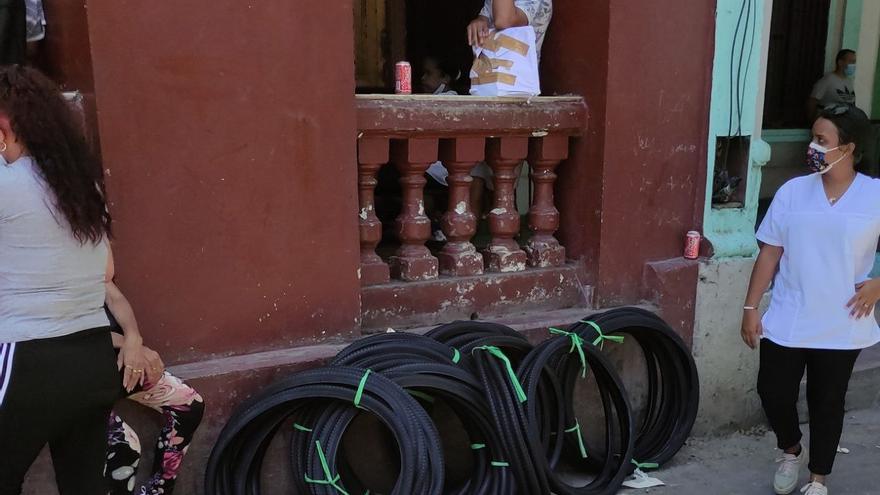
![]() 14ymedio, Mercedes García / Juan D. Rodríguez, Sancti Spíritus / Havana, 4 May 2022 — The shortage of bicycle tires drives Cubans from the provinces crazy, where there are no transportation options like the ones that still exist in a city like Havana. These days, in Sancti Spíritus, acquiring a single tire can cost up to 4,200 pesos. And only in the informal market.
14ymedio, Mercedes García / Juan D. Rodríguez, Sancti Spíritus / Havana, 4 May 2022 — The shortage of bicycle tires drives Cubans from the provinces crazy, where there are no transportation options like the ones that still exist in a city like Havana. These days, in Sancti Spíritus, acquiring a single tire can cost up to 4,200 pesos. And only in the informal market.
“Here they never offer tires for sale and everyone has a bicycle,” says Rayner, who lives ten kilometers from the center of Sancti Spíritus and, as he says, “either you go by bus, which passes by twice a day, or you go on foot.” The young man says that this same Tuesday he paid 3,600 pesos for the tire for the front wheel that he needed, his income for the entire month.
The tires of his bicycle, which is eight years old, could not perform anymore, having been repaired with bits of shoes and rubber over and over.
Four months ago, he bought the tire for the rear wheel and it cost him 4,000 pesos, “and almost crying to the man who sold it to me, because there aren’t any,” he tells this newspaper. Since then, he has been saving for the front tire.
Meanwhile, in the Cuban capital, this Wednesday, a long line formed at a state store in Plaza de Carlos III where they had put out rubber tires for sale, for $5.33 each.
The customers who came out of the store did not carry one or two, but many. “Here I never see anyone on a bicycle,” commented a woman who passed by the place, surprised. “These are most likely going to be taken to the countryside to sell.”
Tires suffer great wear and tear in Cuba, not only because of the frequent use of bicycles as a means of transportation, but also because of the poor condition of the streets and the terrible condition of the brakes in many of these vehicles, which forces their drivers to brake by rubbing the tire with the sole of the shoe.
Streets with large areas where the asphalt is missing and plenty of potholes are common throughout the Island, but in the cities and country towns the situation is even worse. Also objects on the road, such as broken bottles, pieces of metal and even nails add greater risks. Hence the need to have frequent spare parts to replace the tires that are deteriorating.
To this we must add that the bicycle is also a means of family transportation, frequently used by street vendors to cover a wider area of potential customers, or an improvised moving truck, and it is also common to add motors to increase speed, an ingenuity that is popularly known as riquimbili. [For photos, see here.]
The bicycles transformed into light motorcycles, after adding an engine, also consume the useful life of the tires more quickly. But not all the ones that are sold are of good quality, the least valued are the so-called Creole rubbers, of domestic manufacture, while the imported ones can cost much more in the informal market.
____________
COLLABORATE WITH OUR WORK: The 14ymedio team is committed to practicing serious journalism that reflects Cuba’s reality in all its depth. Thank you for joining us on this long journey. We invite you to continue supporting us by becoming a member of 14ymedio now. Together we can continue transforming journalism in Cuba.
